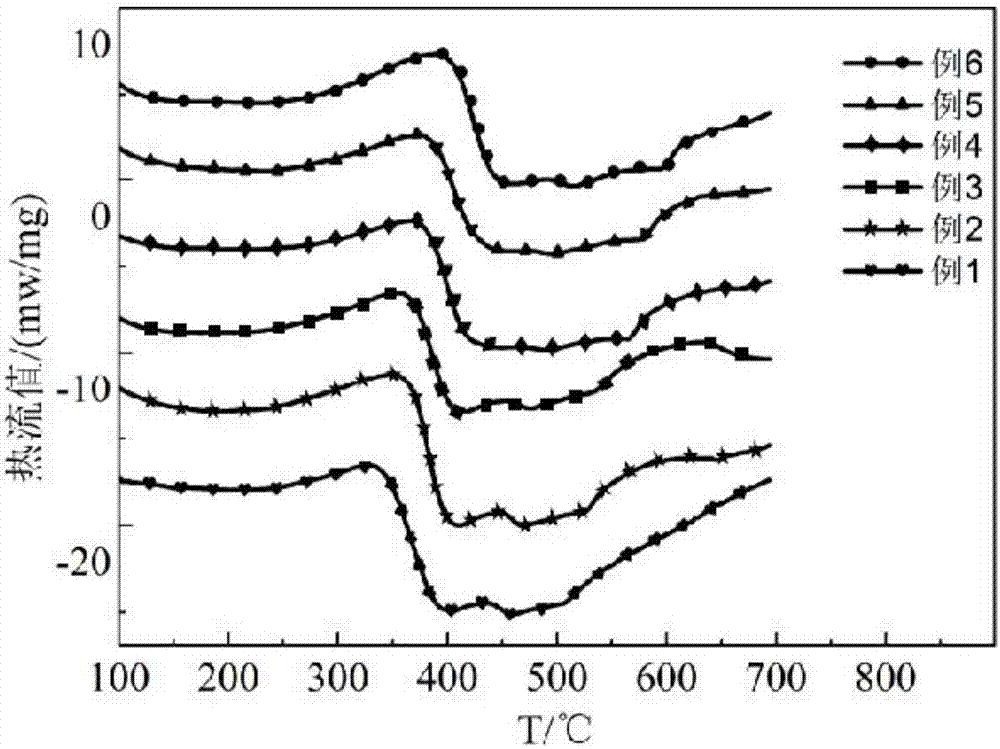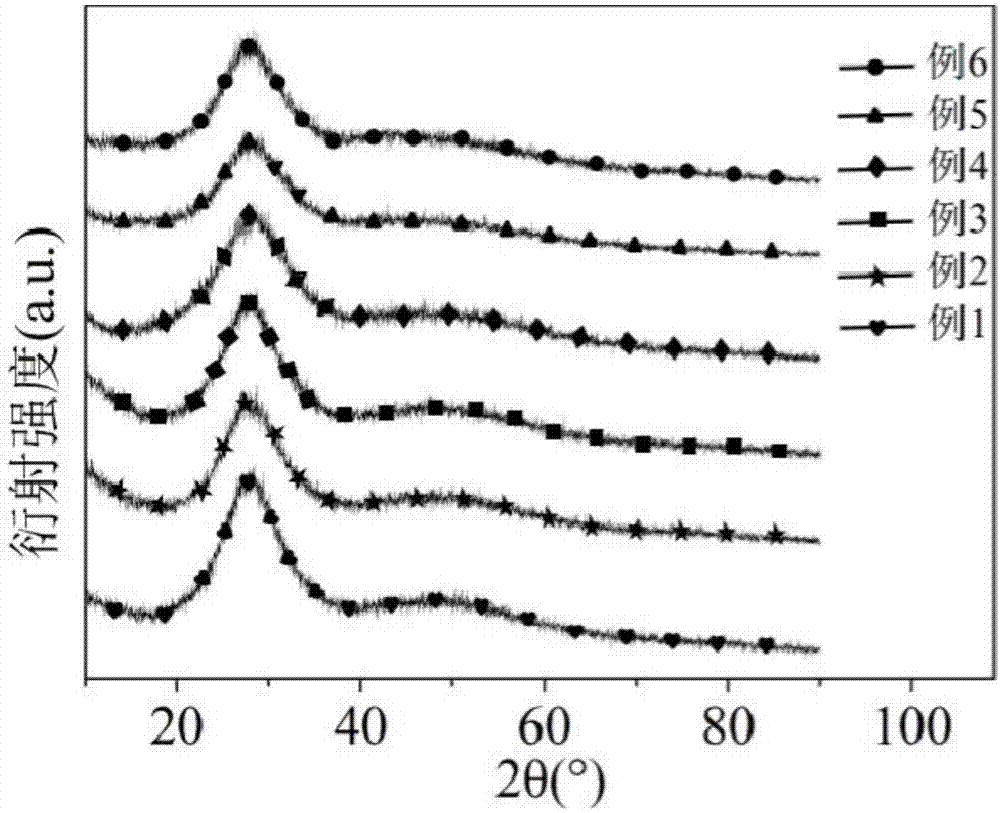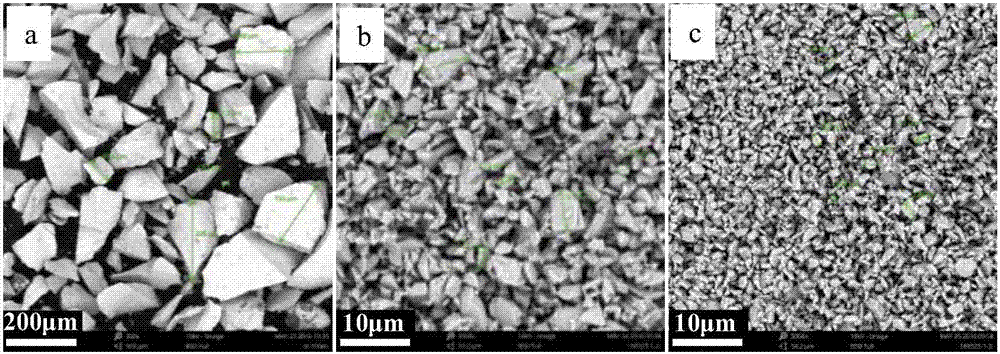Glass powder used for silver paste on front surface of crystalline silicon solar cell and preparation method of glass powder
A technology for solar cells and glass powder, applied in the field of solar cell materials, can solve the problems of high glass transition temperature, high sintering temperature of glass powder, uneven particle size, etc., and achieves the effects of low cost, low melting point and increased utilization rate
- Summary
- Abstract
- Description
- Claims
- Application Information
AI Technical Summary
Problems solved by technology
Method used
Image
Examples
Embodiment 1
[0040] Weigh 100g of the ingredients according to the composition ratio in Example 1 in Table 1, grind and mix them evenly, place them in a corundum alumina crucible, put them in a muffle furnace for heating after numbering, gradually increase from room temperature to 850°C, and keep warm for 2 Hours, to obtain a glass melt; pour the obtained glass melt into deionized water for water quenching to obtain glass shards, and then dry the glass particles in a blast drying oven at 70°C for 3 hours; the dried glass particles Carry out manual grinding, pass through 400 mesh and 100 mesh screens respectively, and obtain glass powder coarse powders of 30-90 μm and 100-220 μm respectively; conduct ball milling on glass powders passing through 100 mesh screens twice, and the diameters of the three kinds of grinding balls used are They are 10mm, 8mm and 5mm respectively. The primary ball milling process is: ball-material ratio 2:1, ball grading ratio of large, medium and small balls 1:1:1,...
Embodiment 2
[0043] Weigh 100g of the ingredients according to the composition ratio in Example 2 in Table 1, grind and mix them evenly, place them in a corundum alumina crucible, put them in a muffle furnace for heating after numbering, gradually increase from room temperature to 900°C, and keep warm for 1 Hours, to obtain a glass melt; pour the obtained glass melt into deionized water for water quenching to obtain glass shards, and then dry the glass particles in a blast drying oven at 100°C for 2 hours; the dried glass particles Carry out manual grinding, pass through 400 mesh and 100 mesh screens respectively, and obtain glass powder coarse powders of 30-90 μm and 100-220 μm respectively; conduct ball milling on glass powders passing through 100 mesh screens twice, and the diameters of the three kinds of grinding balls used are They are 12mm, 8mm and 4mm respectively. The primary ball milling process is: ball-to-material ratio 2.5:1, the ball grading ratio of large, medium and small ba...
Embodiment 3
[0046] Weigh 100g of the ingredients according to the composition ratio in Example 3 in Table 1, fully grind, stir and mix them evenly and place them in a corundum alumina crucible. Hours, to obtain a glass melt; pour the obtained glass melt into deionized water for water quenching to obtain glass shards, and then dry the glass particles in a blast drying oven at 120°C for 1 hour; the dried glass particles Carry out manual grinding, pass through 400 mesh and 100 mesh screens respectively, and obtain glass powder coarse powders of 30-90 μm and 100-220 μm respectively; conduct ball milling on glass powders passing through 100 mesh screens twice, and the diameters of the three kinds of grinding balls used are They are 12mm, 9mm and 7mm respectively. The primary ball milling process is: ball-material ratio 4:1, ball grading ratio of large, medium and small balls 16:4:1, rotating speed 300r / min, solid-liquid ratio 1:1, ball milling time 4h, secondary ball milling process is: ball m...
PUM
| Property | Measurement | Unit |
|---|---|---|
| particle size | aaaaa | aaaaa |
| glass transition temperature | aaaaa | aaaaa |
| particle diameter | aaaaa | aaaaa |
Abstract
Description
Claims
Application Information
 Login to View More
Login to View More - R&D
- Intellectual Property
- Life Sciences
- Materials
- Tech Scout
- Unparalleled Data Quality
- Higher Quality Content
- 60% Fewer Hallucinations
Browse by: Latest US Patents, China's latest patents, Technical Efficacy Thesaurus, Application Domain, Technology Topic, Popular Technical Reports.
© 2025 PatSnap. All rights reserved.Legal|Privacy policy|Modern Slavery Act Transparency Statement|Sitemap|About US| Contact US: help@patsnap.com



